Tower
Work is continuing on the house in October, but it has been slow and my next post on progress is pending. In the meantime, here is a digression on a side project I have been working on myself. We had a couple of scrap SIP pieces leftover from the roof. I grabbed them for myself to do a little project I had in mind. I wanted to build a small deck or platform down by one of the creeks, at the opposite corner of the property to the house. I realized that these SIPs would be perfect for such a platform.
Pictured is what I have completed so far. The SIPs are the dark pieces forming the raised platform, which is about 11 feet in the air. The creek is at the bottom of a steep ravine, and this is the only sort-of flat spot. It has a very hidden away feeling. We have a couple of hiking trails that end up here, so it makes a nice spot to go to and feel away from everything. The ravine is also a pinch point for deer moving from up on top of the hills down to the river, so this is also an ideal hunting spot.
The steep ravine also makes getting materials to the site a big challenge. I moved the SIPs and other lumber down to the spot by sliding them down the trail on a tarp. This worked well, and it turned out that hiking back up with tools was much more exhausting than moving the heavy materials down.
Looking around for ideas on how to build it, I found these specialty brackets for building raised hunting blinds. They are the black steel things seen above where I am framing the underside of the platform. A treated 4x4 piece of lumber slides into each bracket, making a leg for the platform. The brackets greatly simplify the design of the tower and reduce the amount of lumber needed to build it.
Following the instructions for the brackets, the tower is constructed on its side and the raised into position by pulling it with a winch or a vehicle.
The structure is completed with some cross bracing members on each face. The spot is relatively level, but not entirely. It drops about 18-24" from one side of the the tower to the other, so there is a tendency for the structure to want to roll down hill and into the creek. Hence, I have some cable and straps between a tree and the structure to arrest that movement.
To level the tower once raised, I dug some holes on the uphill side where the two legs would land. One is 18" deep and the other 24" deep. This was the hardest work of the project, and I even broke one shovel doing it. The ground here is rock suspended in heavy clay and covered with a dense web of tree roots.
The most challenging and nerve wracking part was raising the tower to standing. I did so using a two power pullers, which are a sort of hand winch, a farm jack, which is that red painted 60" long piece of equipment see in the pictures, and a whole lot of cables, straps, and ropes.
I have long wanted a farm jack, a.k.a. a high-lift jack, and I finally had an excuse to get one! I used it to lift the platform end, while I used a power puller to pull from high end of the platform and another power puller pulling down on the end of the two legs that were up in the air. The result was that I was rotating the platform around the ends of the two legs that were laying on the ground. I learned I needed the jack part of the solution after my first attempt at lifting. The tendency was to simply drag the tower along the ground, rather than rotating up.
In addition to the pulling straps, I also had to use a series of straps to stabilize the tower as it rotated. To move it, I had to incrementally jack it up a little bit, pull on the power puller a little bit, then loosen or move the stabilizing straps, and then repeat over and over. In all, it took me about 6 hours of iterating to get the thing tipped over. However, I did it by myself and without injury, which is a win!
Here are the view from the top looking upstream and downstream. There is about a four foot drop from the flat spot where the tower site down to the creek, so it ends up feeling like one is very much up in the trees. The main part of the platform is 6' by 7'. My rough attempt at leveling the tower ended up giving it a couple inches of slope in both directions. That worked out ok, as it feels level when standing on it, but it should shed water well. I am going to cover the exposed SIP with roofing felt to waterproof it. My further plan is to build a little structure on top with safety rails and a simple roof to shed rain. I will probably build a nicer, permanent ladder as well.
Pictured is what I have completed so far. The SIPs are the dark pieces forming the raised platform, which is about 11 feet in the air. The creek is at the bottom of a steep ravine, and this is the only sort-of flat spot. It has a very hidden away feeling. We have a couple of hiking trails that end up here, so it makes a nice spot to go to and feel away from everything. The ravine is also a pinch point for deer moving from up on top of the hills down to the river, so this is also an ideal hunting spot.
The steep ravine also makes getting materials to the site a big challenge. I moved the SIPs and other lumber down to the spot by sliding them down the trail on a tarp. This worked well, and it turned out that hiking back up with tools was much more exhausting than moving the heavy materials down.
Looking around for ideas on how to build it, I found these specialty brackets for building raised hunting blinds. They are the black steel things seen above where I am framing the underside of the platform. A treated 4x4 piece of lumber slides into each bracket, making a leg for the platform. The brackets greatly simplify the design of the tower and reduce the amount of lumber needed to build it.
The structure is completed with some cross bracing members on each face. The spot is relatively level, but not entirely. It drops about 18-24" from one side of the the tower to the other, so there is a tendency for the structure to want to roll down hill and into the creek. Hence, I have some cable and straps between a tree and the structure to arrest that movement.
To level the tower once raised, I dug some holes on the uphill side where the two legs would land. One is 18" deep and the other 24" deep. This was the hardest work of the project, and I even broke one shovel doing it. The ground here is rock suspended in heavy clay and covered with a dense web of tree roots.
The most challenging and nerve wracking part was raising the tower to standing. I did so using a two power pullers, which are a sort of hand winch, a farm jack, which is that red painted 60" long piece of equipment see in the pictures, and a whole lot of cables, straps, and ropes.
I have long wanted a farm jack, a.k.a. a high-lift jack, and I finally had an excuse to get one! I used it to lift the platform end, while I used a power puller to pull from high end of the platform and another power puller pulling down on the end of the two legs that were up in the air. The result was that I was rotating the platform around the ends of the two legs that were laying on the ground. I learned I needed the jack part of the solution after my first attempt at lifting. The tendency was to simply drag the tower along the ground, rather than rotating up.
In addition to the pulling straps, I also had to use a series of straps to stabilize the tower as it rotated. To move it, I had to incrementally jack it up a little bit, pull on the power puller a little bit, then loosen or move the stabilizing straps, and then repeat over and over. In all, it took me about 6 hours of iterating to get the thing tipped over. However, I did it by myself and without injury, which is a win!
Here are the view from the top looking upstream and downstream. There is about a four foot drop from the flat spot where the tower site down to the creek, so it ends up feeling like one is very much up in the trees. The main part of the platform is 6' by 7'. My rough attempt at leveling the tower ended up giving it a couple inches of slope in both directions. That worked out ok, as it feels level when standing on it, but it should shed water well. I am going to cover the exposed SIP with roofing felt to waterproof it. My further plan is to build a little structure on top with safety rails and a simple roof to shed rain. I will probably build a nicer, permanent ladder as well.
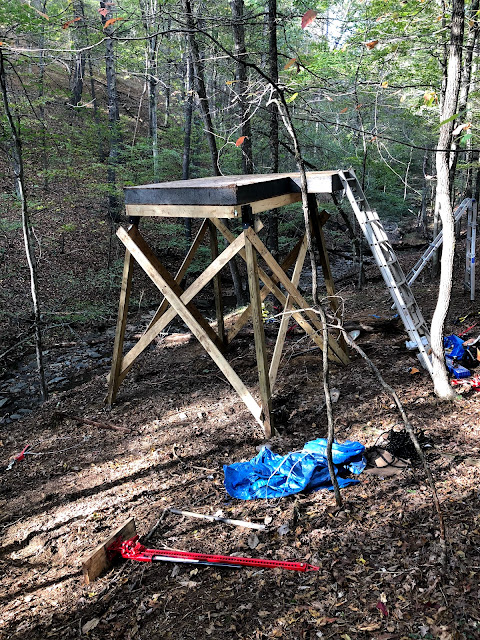
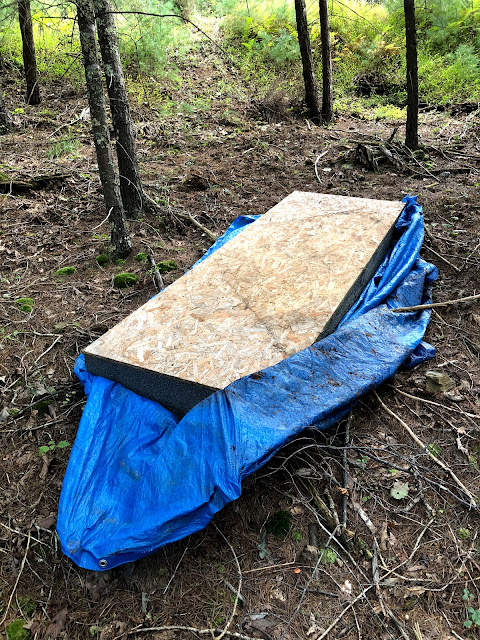

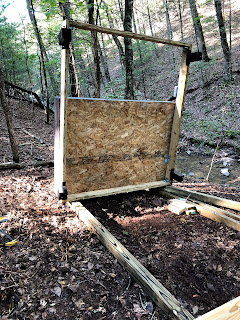





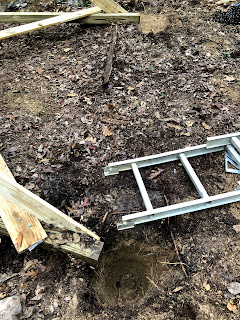










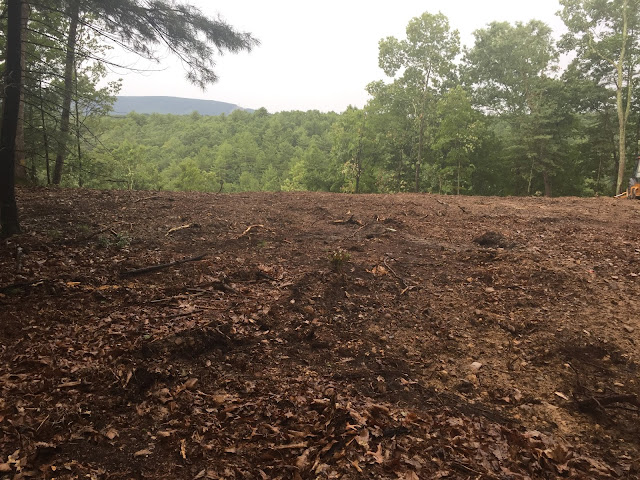
Comments
Post a Comment